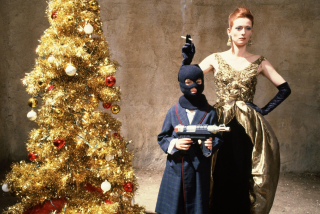REWARDS OF SAVING OLD FILMS
- Share via
The world-premiere performance Wednesday night at UCLA of the restored 1927 French film “Casanova,” with a new score donated by French composer Georges Delerue, was an event with multiple significances.
It demonstrated the close and growing cooperation between the Cinematheque Francaise and the UCLA Film Archive. It was a vivid launching for Cinema 89, an enterprise led by Robert Maniquis, a UCLA professor of English who is also a dedicated and scholarly film buff, that will mount a movie observance of the 200th anniversary of the French Revolution in 1989. The longer-range aim is to enhance UCLA’s collection of French films.
And, far from least, the premiere of the tinted, restored “Casanova,” rhapsodically reviewed by Martin Bernheimer on Wednesday, was a kind of intercontinental reminder of the urgent but costly need for film preservation--and the often astonishing rewards of it.
The new director of the Cinematheque Francaise, Bernard Latarjet, the third in succession to its famous founder, Henri Langlois, who died in 1977, has been in Los Angeles for the “Casanova” premiere. He was accompanied by Renee Lichtig, a veteran editor who worked with Jean Renoir and other directors and who edited “Casanova.”
Latarjet, who trained as an agricultural engineer (as did the avant-garde novelist Alain Robbe-Grillet, he notes), was recruited from the Ministry of Agriculture by Constantin Costa-Gavras, president of the Cinematheque.
In a breakfast conversation with Maniquis and Robert Rosen of the UCLA archive, Latarjet sketched the dimensions of the restoration challenge.
The Cinematheque, he said, possesses 15,000 nitrate films. It is able to restore on safety film about 150 a year. It will thus take only a century to finish the job (assuming, which cannot be assumed, that no new acquisitions on nitrate stock will be made).
Langlois, who started the Cinematheque in September, 1936, when he was 22, “was a collector, not an archivist,” Latarjet said. He grabbed anything and everything he could get his hands on, and it is lucky for film history that he did.
As it is, the best guess is that 25% of the French films made before 1950 have been lost. (Rosen said the estimate for pre-1950 U.S. films is that closer to 50% have been lost.)
The Cinematheque is even now not certain what it does possess. Five researchers are working full time to take inventory and log it into computers. It will take five years to complete the job.
A disastrous warehouse fire in 1980 destroyed a large quantity of the Cinematheque’s unresearched holdings. The loss, Latarjet said sadly, is truly incalculable because no one can be sure what all was indeed lost.
The need to transfer onto safety stock is urgent because nitrate film notoriously decomposes into a highly explosive state, and is extremely flammable at any point in its life. (The more recent urgency is that color negatives fade and change unless they are renewed, a crusade that engages Martin Scorsese and other film makers.)
The UCLA archive, Rosen said, has something like 50 million feet of nitrate film it would like to transfer, including 14 million feet of newsreel that constitutes an important historical resource. It is stored off-campus.
The Cinematheque’s nitrate treasures are stored, like explosives, in small, distinct vaults, so that even if one is lost, the fire cannot spread to the others.
Latarjet said the Cinematheque has an annual budget of $5 million, the largest part--80%--a direct government grant, the balance from ticket and book sales and private donations.
“Georges Delerue would have been beyond our dreams,” said Latarjet. But Delerue, who lives in Los Angeles, gave his time and work to the project. Even so, the cost of rehearsals and performances by the 15-piece orchestra ran to more than $35,000, and the total cost was about $65,000 for the event--a worthwhile investment in the cause of preservation, said Maniquis of Cinema 89.
“Casanova” subsequently will be shown/performed in Paris, probably at the Paris Opera, and possibly at the Venice Film Festival this summer, an appropriate setting since Venice figures importantly in the film.
One of the most remarkable retrievals by the Cinematheque was a film shot in 1920 but abandoned by the producers and never edited together. “We found the rushes three years ago,” Latarjet said. “Even the director had never seen them.” He was Andre Antoine, an early and evidently too innovative film maker. Pathe examined the rushes and shelved it.
No script or notes survive, so the archivists went to the principal locations to help make sense of the shots. “It was the longest post-production in history,” said Latarjet. Assembled as “The Swallow and the Cuckoo” and scored by one of the young French composers, it was shown at last year’s Telluride (Colo.) festival.
Competition and secrecy used to characterize the relations among film archives, Latarjet and Rosen agree. In France, Langlois’ Cinematheque competed for acquisitions with the National Archive, though both are government-supported. In the last decade the situation has changed dramatically, as evidenced by the “Casanova” event, which makes the film available to UCLA and the music available to the Cinematheque and eventually, it is hoped, the world.
The Cinematheque, Latarjet said, circulates about 400 films a month to other archives, campuses, venues beyond its own walls.
Now, Rosen said, “It’s no longer necessary to have everything, but to know where a film is, what shape it’s in, and whether you can borrow it. After the years of scandalous inattention to film history, it’s a new day. Now if we just had enough money.”
More to Read
Only good movies
Get the Indie Focus newsletter, Mark Olsen's weekly guide to the world of cinema.
You may occasionally receive promotional content from the Los Angeles Times.










